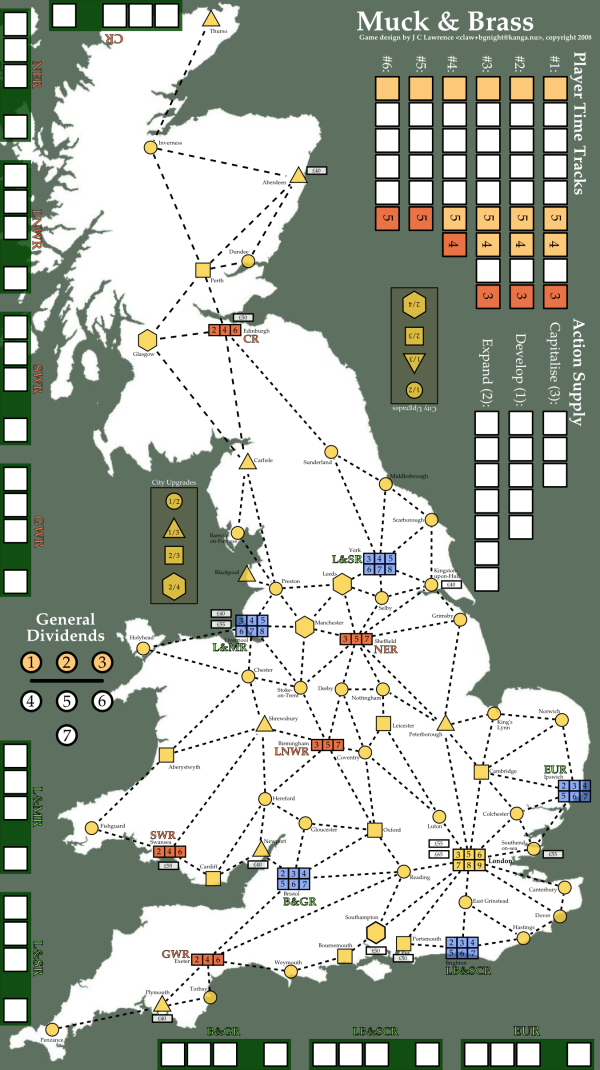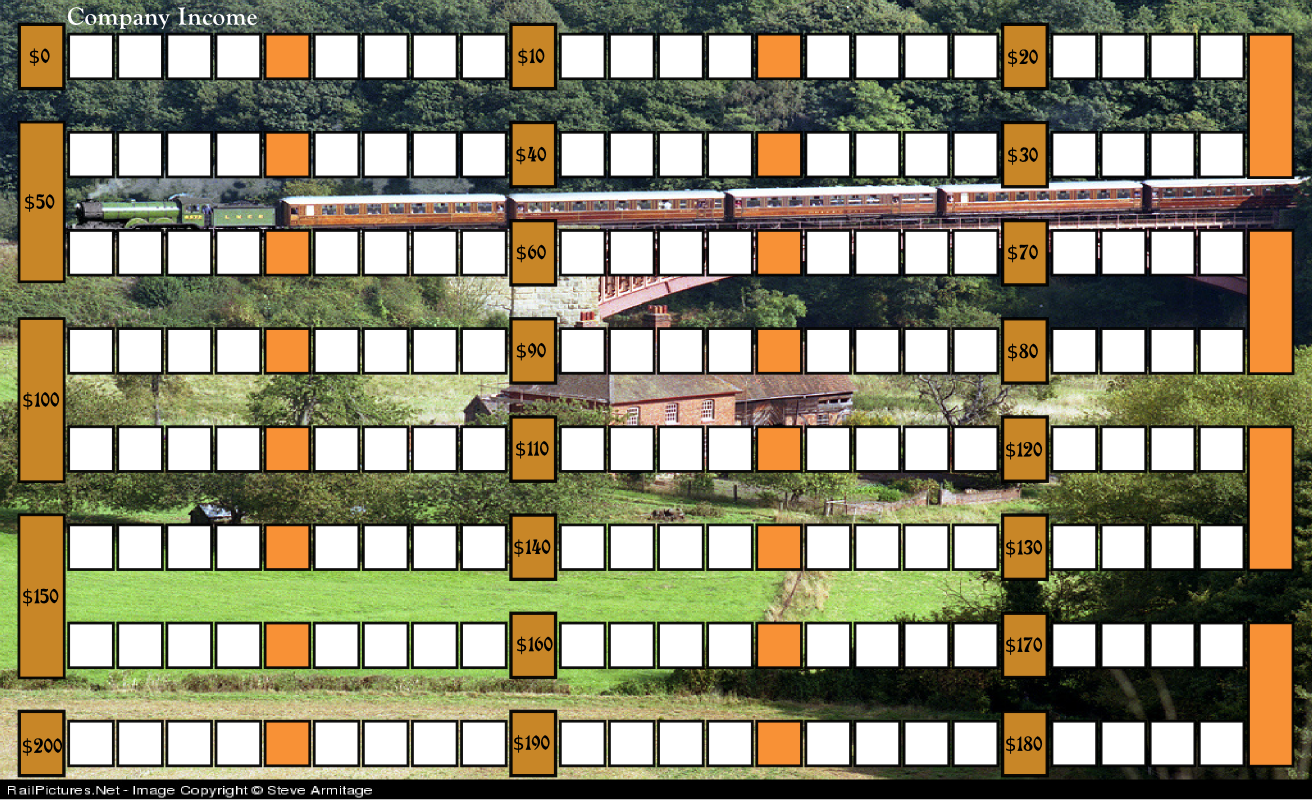I wrote previously on Duck Dealer and got it all so embarrassingly wrong. Here’s the corrected version I promised.
Duck Dealer is a far simpler game and is a much closer derivative of Merchant of Venus than it first appears. Like Merchant of Venus there are only a few things in the game which are important. The rest is incidental.
There are only two things in the game which are really important: 50 point factories and 50 point consumer tiles. The 50 point consumer tiles are consolation prizes for the people who didn’t get there in time to build the 50 point factory. The 30 point consumer products are consolation prizes for the people who were dawdled and didn’t get either. With rare exception nothing else in the game matters; only the 50 point factories and 50 point consumer tiles are important. Everything else is either an incidental, a consolation prize or a stocking stuffer because there’s nothing else better left to do.
Examine the consumer tile table board carefully before the game starts. One of the bottom two tiles is not going to be placed. Which one won’t make it? Look at the mine placements. Look for synergies in the patterns of mines that lead toward specific 50 point consumer tiles as contrasted to the order of availability of those consume tiles. There should be 2-3 obvious opportunities. Those are what you and the other players will be heading for. Your goal is to get ownership markers on all the buildings in one or more production chains that have a 50 point consumer tile at their end. With good players you won’t get everything in the chain so compromises will need to be made. Look to the efficiency points along the way. Where in that process chain will you be spending the most discs? Forgo ownership markers on buildings which are used less frequently in your chain than those used more often. The goal is to be able to cycle from mines all the way up to 50 point consumer tile products as quickly as possible (least number of energy-taking turns required).
Your teleport link has two main purposes:
- To add efficiency to your production loop
or:
- To get you to or from your production loop when re-jiggering your ship configuration before another player can interfere with your efficiency
Offensive use of teleport links is almost irrelevant. Using other’s teleport placements to increase your own efficiency is delightful.
The ideal situation is a loop of four mines in a row, needing only one red disc for each move between them, each mine paired with the proper adjacent factory, no back-and-forthing required for ideal production, and a telport from the end back to the start where the 50 point factory and consumer are placed (or one of the trivial variants of that pattern).
Once you have secured a 50 point factory tile and its matching consumer tile and built/flipped them both as applicable, there is a simple choice. Which is more efficient: to cycle on your loop for 30 VPs per product or to run off and cherry pick other 50 point factory or consumer tiles? If your ownership markers are well placed it will usually be to run your own cycle. However there’s a potentially interesting tactical decision, especially if it also provides the opportunity to bork other player’s hopes and plans.
Opportunism is everything. The other players will also see the same opportunities you do. They will be pursuing the same goals and possibilities you re looking toward. Getting there first and sewing up the key points along the way is critical. In doing this the key question is opportunity cost. By acting early you can get the jump on them, but by waiting you’ll have more energy and will be able to do/secure more. Attempting to correctly time the relative advantages of that decision forms a large portion of the game. This is the race portion of the game. It is entirely a question of who gets there first. Who gets the 50 point factory first? Remember: consumer tiles are a consolation prizes for the player(s) who didn’t get the factory. Careful timing and watching of the energy potentials of the other players is key. Count carefully and often.
All ship sizes are viable – for different purposes. A 1 hold ship can be very effective at sewing up the early stages of a production route before the players building out their ships can get there. However you’ll need to go back and reconfigure for more holds to make your 50 point tile runs. A 5 or 7 hold ship seems about minimal for making efficient 50 point tile runs but bigger can be better. Depending on your success in securing your production chain, bigger ships of various configurations make sense. Final ship configuration is entirely a question of minimising energy-taking turns per VP earned (or VP blocked from another player).
As the end-game approaches and players start sewing up their runs the VPs should come flooding in. 200 points in a single action is not uncommon an I’ve seen as many as 300 in a single action. This is why the little 3 and 10 etc point returns for smaller factories and consumers are just noise. In a tight game they may make the difference but that can’t be planned and accounted for at the start of the game and thus should be ignored. The big 50 point and 30 point runs at the end of the game are the goal to focus on and the primary determining factor in the game. One delivery of 5 top-level consumer products earns a minimum of 150 points. The real question is: How often can you do that or better?
The primary value of the 10 and 25 point consumer tile placements is to reduce the efficiency of other player’s production loops. They’re not worth bothering with otherwise. Flipping them yourself wastes a product that could be better spent building a 50 point factory or flipping a 50 point consumer. Put low value consumer tiles where other players wanted to ideally put their 50 point consumer tiles. Low value consumer tiles are more valuable as blocks than for points. There’s a similar though much reduced value for the lower point factories (the one’s you don’t need for your loop but others do for their’s). Put their desired factories in the wrong places and force them to be inefficient. The ideal is to have the factory adjacent to one of its inputs and logistically after its first input location. It is sometimes possible to ensure that a given 50 point factory is never placed and can never be placed. Also remember that one of the 50 point consumer tiles cannot be placed in every game. There is often advantage in ensuring that the factory or consumer tile another player was building towards is the one that won’t be placed, or if it will be placed, that it is on the opposite side of the board from their production chain. Of course they’re also thinking the same thoughts about your chain, so some attention to preventive defence may be in order. Opportunistic collateral damage is a wonderful thing.
Beware of the end-game. Most of the game consists of setting up for massive point runs in the end-game. It is not unusual for a player to have almost no points before they start their big end-game runs. In this way the game is extremely end-loaded. Most games end with players acting every turn and forcing the end-game, thus forcing other players to accelerate out of efficiency or else never get to act at all. It is not uncommon for a different player to have won if only they’d had one more energy-taking round or a slightly different mix of energy in-hand before the end-game rush started. Count, calculate and plan carefully.

